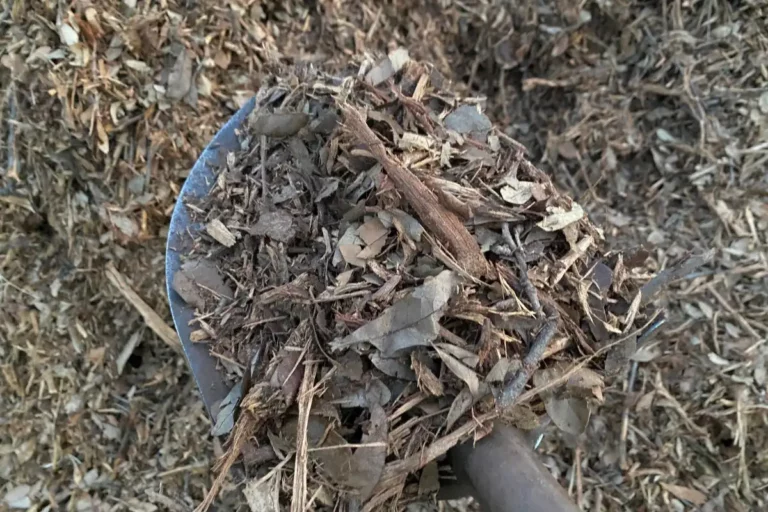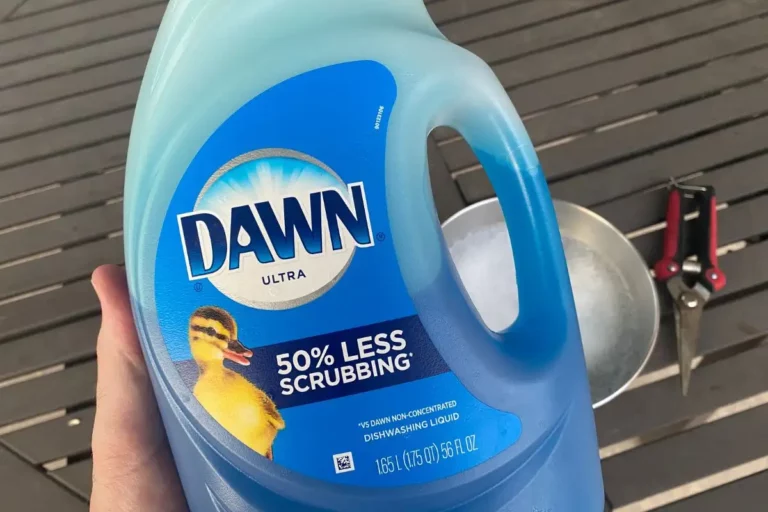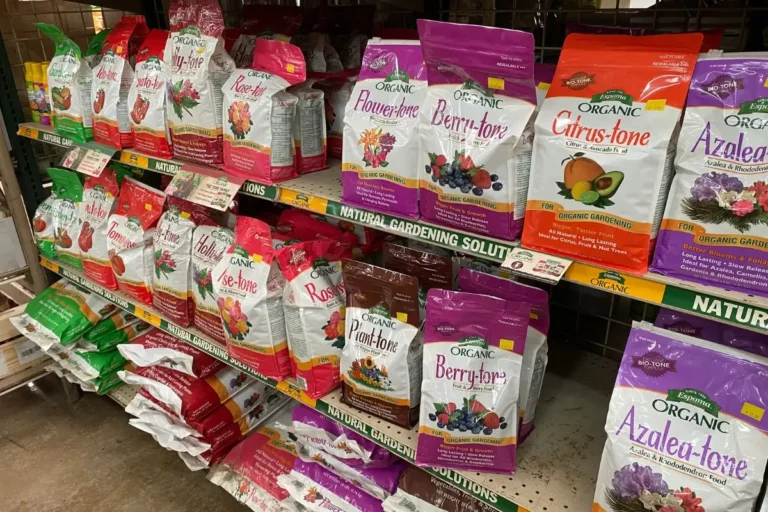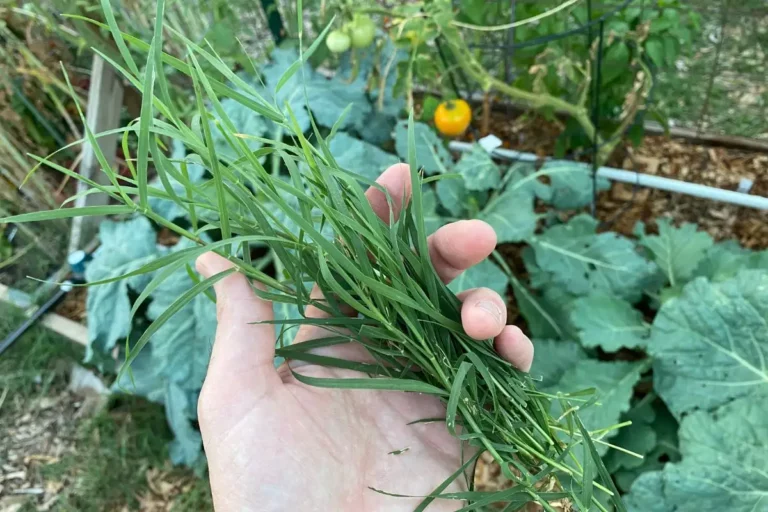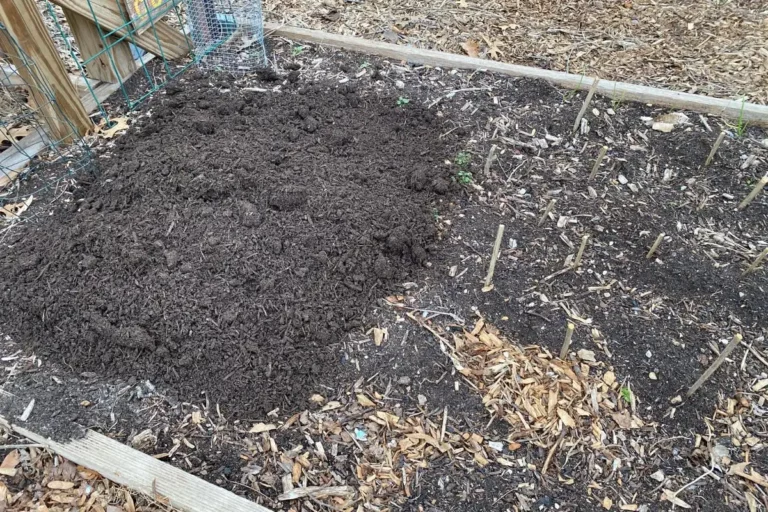What Goes at the Bottom of a Compost Pile? 9 Things to Add
I’ve written several articles on how to start raised garden beds—including what to put in the very bottom of raised beds to get the most out of them—but when I started composting in my backyard, I began thinking more about how to start compost piles as well.
What should I put in the bottom of my compost bin? What kind of materials would help improve my compost and get things off on the right track?
The best materials to add to the bottom of a compost pile are layers of cardboard followed by small sticks, livestock manure, leaves, and grass clippings. Adding several shovelfuls of native garden soil can help jumpstart the composting process by incorporating microorganisms into the pile.
In this article, you’ll learn all you need to know to start composting in your backyard, including:
- Specifics on how I layer new compost piles, starting with the bottom layer and moving up.
- A detailed list of all the materials I add to my compost.
- Insights on how to make sure you’ve got a proper carbon-to-nitrogen ratio in your compost pile.
- Descriptions of how I add cardboard to the bottom of my compost pile and how I integrate cardboard pieces into the compost itself.
After you’ve been composting for a few months, you’ll find it’s a pretty easy process, but when you’re just getting started, there’s a lot to think about.
My goal with this article is to give you all you need to know to start composting in your backyard, whether you’ve got plenty of land to work with or a small backyard (as I do).
Before we begin, here are some items that’ll help you compost. Get your hands on them (or something like them), and you’ll be good to go!
9 Things to Add to the Bottom of Your Compost Bin or Pile
Before explaining how I layer my compost, I’ve got a quick question for you: Do you want to install a compost bin or compost pile on your property?
There’s a difference between the two, so I thought I’d explain what I mean.
A compost bin is exactly what it sounds like: a bin or container of some kind that you use to keep your compost contained.
Some people install one bin. Others install two. Many people even use a three-bin system where the first bin is for fresh materials, the second bin is for semi-composted materials, and the third bin is for mostly composted materials.
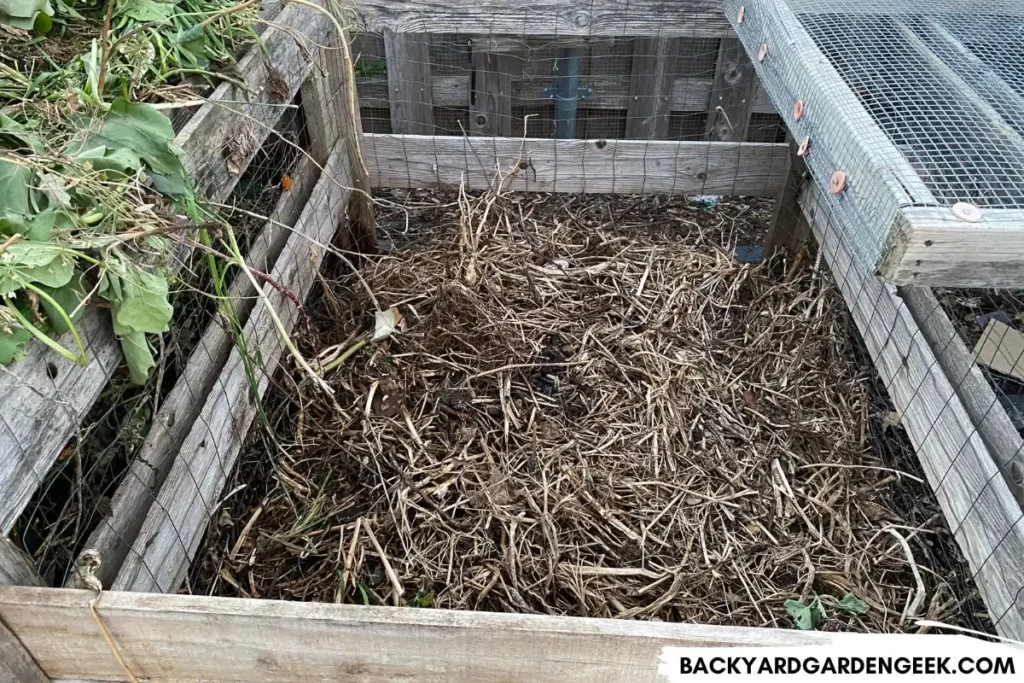
This is my favorite approach to composting because it supercharges the process. It requires a bit more work since you need to transfer the material at the bottom of each bin into the next bin, but by the end, you’ll be left with amazing compost for your garden.
Generally speaking, you can use just about anything to create a decent compost bin as long as you ensure that there’s good airflow in and around your bin.
Concrete blocks, wooden pallets, wood slats, chicken wire: All of these are perfectly fine since they’ll allow air to reach all sides of your compost.
The compost pile is a little harder to manage, but it’s also simpler to get going.
You literally just pick a corner of your yard, preferably far away from your house, and start piling materials in that corner.
As you gather more materials, you add them to the pile, and the pile grows larger.
Over time, you have to turn the pile, just as you would a compost bin, but the mass of the pile helps with the composting process.
Now that I’ve covered those basics, let’s look at what I put in the bottom of my compost bin.
Whether you’re installing a new compost bin or building a compost pile from scratch, you’ll want to give some thought to how you get things going so as to give your compost the best possible start.
Below, I’ll give a quick overview of what I recommend, followed by detailed instructions about each layer.
Here’s what I put in each layer when starting a new compost pile or filling a new bin. The 1st layer is what goes at the very bottom. The 7th layer is what I tend to throw on top.
| 7th Layer | Kitchen Scraps |
| 6th Layer | Grass and Shredded Cardboard |
| 5th Layer | Leaves and Garden Scraps |
| 4th Layer | Garden Soil |
| 3rd Layer | Farm Animal Manure |
| 2nd Layer | Small Sticks and Plant Stalks |
| 1st Layer | Cardboard |
Layering is almost never this tidy of a process, but in an ideal world, this is what I aim for.
Here’s a brief description of each layer:
First Layer: Cardboard
I don’t want grass or weeds growing into my compost, so I always put down several thick sheets of cardboard on top of the ground where I plan to put my compost bin or pile.
Make sure the cardboard doesn’t have any stickers or glue and that it’s the non-dyed type of cardboard.
(You don’t want chemical dyes leaching into your soil!)
Pizza boxes, particularly the box tops, are actually great for this sort of thing—assuming the boxes are mostly clean—since the dyes they use on pizza boxes are perfectly fine for your garden.

Second Layer: Small Sticks and Plant Stalks
This layer is where I throw down lots and lots of small sticks, twigs, or plant stalks.
I usually create a thick layer of sticks and twigs since this gets the compost going right with a little bit of aeration at the bottom.
Over time, the sticks, twigs, and stalks will deteriorate as the microbes do their work. Unlike how I fill my raised garden beds, I don’t put large pieces of wood in my compost since it’ll take them forever to deteriorate.
Third Layer: Farm Animal Manure
At this point, I like to add some livestock or farm animal manure. You can purchase bags of it at the store if you don’t have access to any nearby sources.
With all that carbon material at the bottom of the pile (both the cardboard and the sticks), I like to give everything a boost of nitrogen as well so that the bottom of the pile has a nice mix of brown and green materials.
Fourth Layer: Garden Soil
Now that you’ve got manure and sticks tossed atop the cardboard, you’ll want to add some soil from your garden. This will help jumpstart your compost pile.
Here’s why: When you add soil from your garden, you’ll inevitably add countless microorganisms from your garden as well.
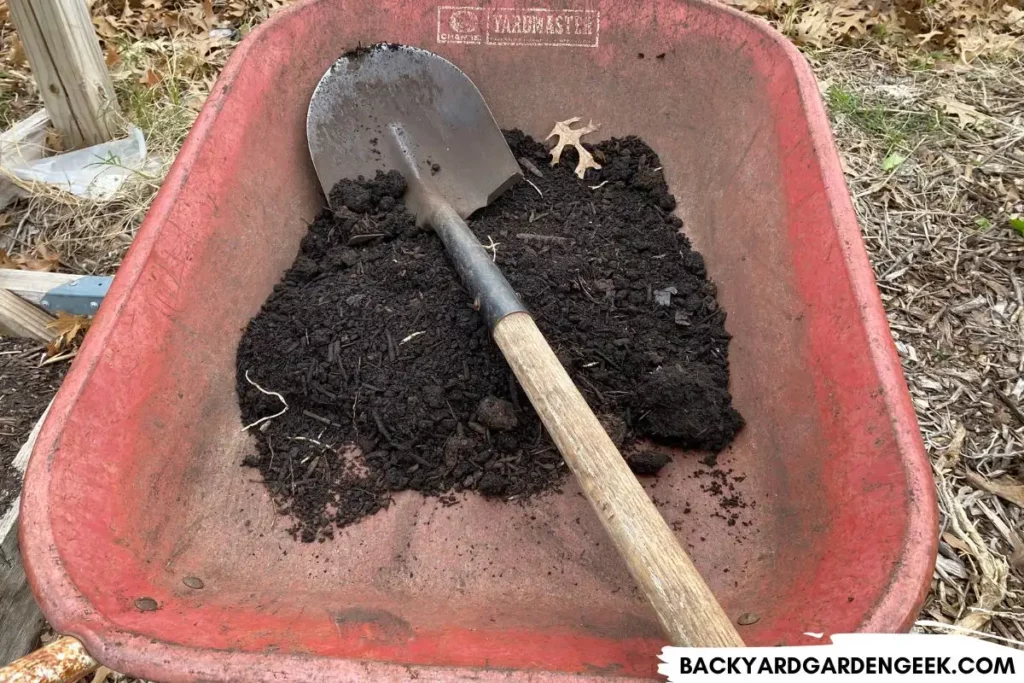
If you don’t do this, it’ll take several months for the cardboard to deteriorate and the microorganisms in your native soil to migrate into your compost
By adding soil from your garden, you get that process going immediately.
Fifth Layer: Leaves and Garden Scraps
To keep your compost properly balanced, you need to make sure that you add enough nitrogen (green materials) and carbon (brown materials).
For every 30 parts of brown material, you’ll need to add 1 parts of green material for a 30:1 ratio.
If you’ve been adding lots of sticks, cardboard, and other brown materials to your compost, this is a perfect time to add leaves and garden trimmings.
Just make sure to avoid adding anything that looks diseased or bug-infested to your compost. If you do, you can spread diseases among your plants or encourage future pest problems.
Sixth Layer: Grass and Shredded Cardboard
Here’s where I like to start adding both shredded cardboard and grass clippings (depending on how much brown and green material I need).
Never add sheets of cardboard to your compost pile. These might take more than a year to disintegrate since they’re so large.
If you add shredded cardboard instead of sheets, especially the kind that’s cross cut, those little pieces of cardboard will disintegrate in only 2-3 months!
Grass is great too. Just don’t add any rhizomatic grasses, like Bermuda grass, since that kind of grass can get a foothold in your compost pile and start growing.
You don’t want grass growing in your compost, so if you do plan to add grass, you might want to make sure it’s 100% dead before doing so
I recommend bagging up grasses in black plastic garbage bags and leaving them out for several weeks in the sun.
This will cook everything inside, and when all the grass particles are crispy and completely dead, you can add them to your compost without worrying about them growing back later and taking over.
Seventh Layer: Kitchen Scraps

You can add kitchen scraps to any layer of your compost, but I like adding them at the top because they decompose so quickly.
I reserve the lower layers of my compost bin for things that take longer to decompose, so kitchen scraps can be tossed on top since they’ll disintegrate in a matter of weeks.
Here’s a list of the kitchen scraps you can always add to your compost:
- Apple cores
- Avocado pits (chopped or smashed for quicker breakdown)
- Banana peels
- Coffee grounds
- Corn cobs and husks
- Cooked or raw fruits (without added sugars or oils)
- Cooked or raw vegetables (without oil or seasonings)
- Eggshells (rinsed and crushed for faster decomposition)
- Expired cereals
- Fruit and citrus peels
- Garlic (crushed or chopped)
- Herbs (stems and leaves)
- Leftover grains and beans (e.g., quinoa, lentils)
- Moldy or old bread (in small-ish quantities)
- Nutshells (except for walnut shells)
- Oats
- Onion skins
- Paper coffee filters or cupcake liners (non-glossy and without plastic coatings)
- Paper egg cartons (shredded or torn into small pieces)
- Paper napkins (without plastic coatings)
- Paper towels and tissues (non-glossy and mostly clean)
- Pasta (cooked or uncooked, without sauce)
- Potato peels
- Salad greens and vegetable trimmings
- Shredded newspaper (non-glossy and without colored ink)
- Stale crackers and cookies
- Tea bags (always remove staples)
- Toothpicks and wooden skewers
- Vegetable peels and scraps
Never compost meat, dairy, bones, oily or greasy foods, pet waste, or diseased plants as any of these may attract pests, slow down the composting process, or transfer diseases to your garden soil.
Should I Put Cardboard at the Bottom of My Compost Bin?
As I noted above, you should add several layers of cardboard sheets to the very bottom of your compost bin or pile.
You’ll want to do this for a few reasons:
First, cardboard will kill off native grasses and keep weed seeds from sprouting. This will keep your compost free and clear of unwanted vegetation.
Second, the cardboard will absorb moisture, which is good when you’re just starting a new compost pile. That added moisture will help keep your compost pile from drying out in the beginning.
Third, the cardboard at the bottom of your compost pile will decompose over the course of 6-8 months or so and turn into carbon-rich material that will enhance your compost.
When composting, you’ll want to keep a ratio of 30 to 1 when it comes to carbon-rich and nitrogen-rich materials, so adding cardboard will help ensure the ratio in your compost is correct.
When it comes to brown and green materials, the ratio in your compost bin doesn’t have to be perfect. It’s just best to put more brown materials than green materials, so get as close to that 30:1 ratio as you can!
More Information
If you’d like to read more about composting, take a look at these articles that I’ve written recently:
- 50 Plants You Should Never Compost (and Those You Should)
- 50+ Cheap Nitrogen Sources for Your Compost Pile
- Composting Pizza Boxes: A Simple, Step-by-Step Guide
- Do Raised Beds Need Yearly Compost? (Here’s What to Do)
- Don’t Compost These Weeds (30+ Plants to Avoid)
- Filling Raised Beds with Just Compost: Should You Do It?
- Is Dawn Dish Soap Safe to Compost?
- Is Your Leftover Pizza Compost-Friendly?
- Should I Put Cardboard at the Bottom of My Compost Bin?


